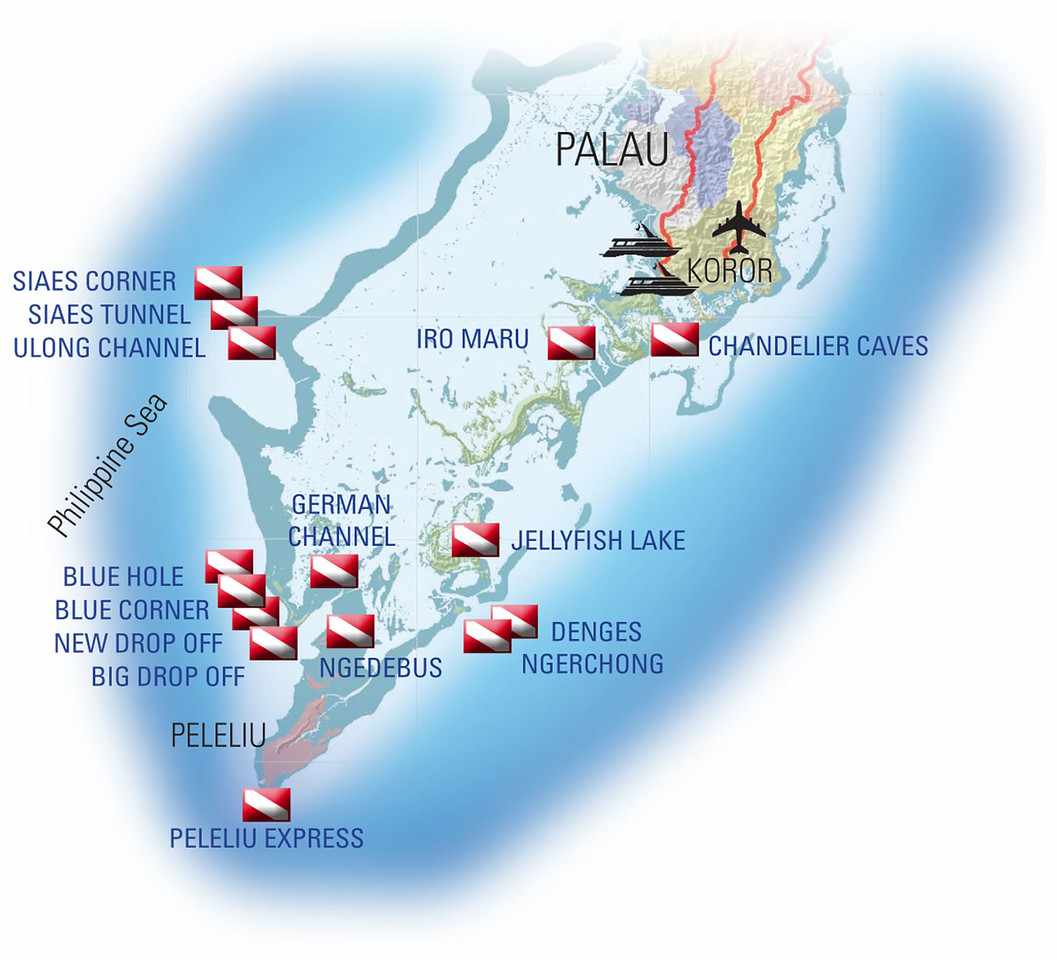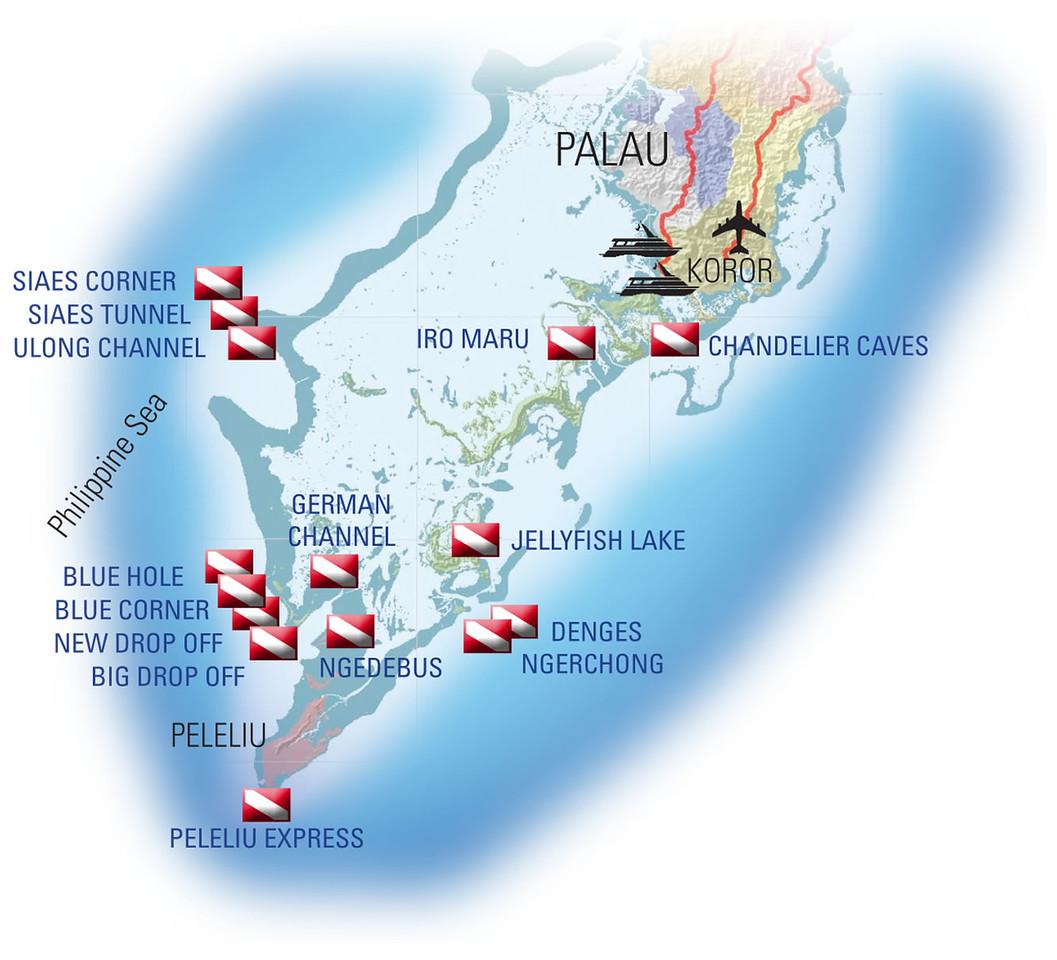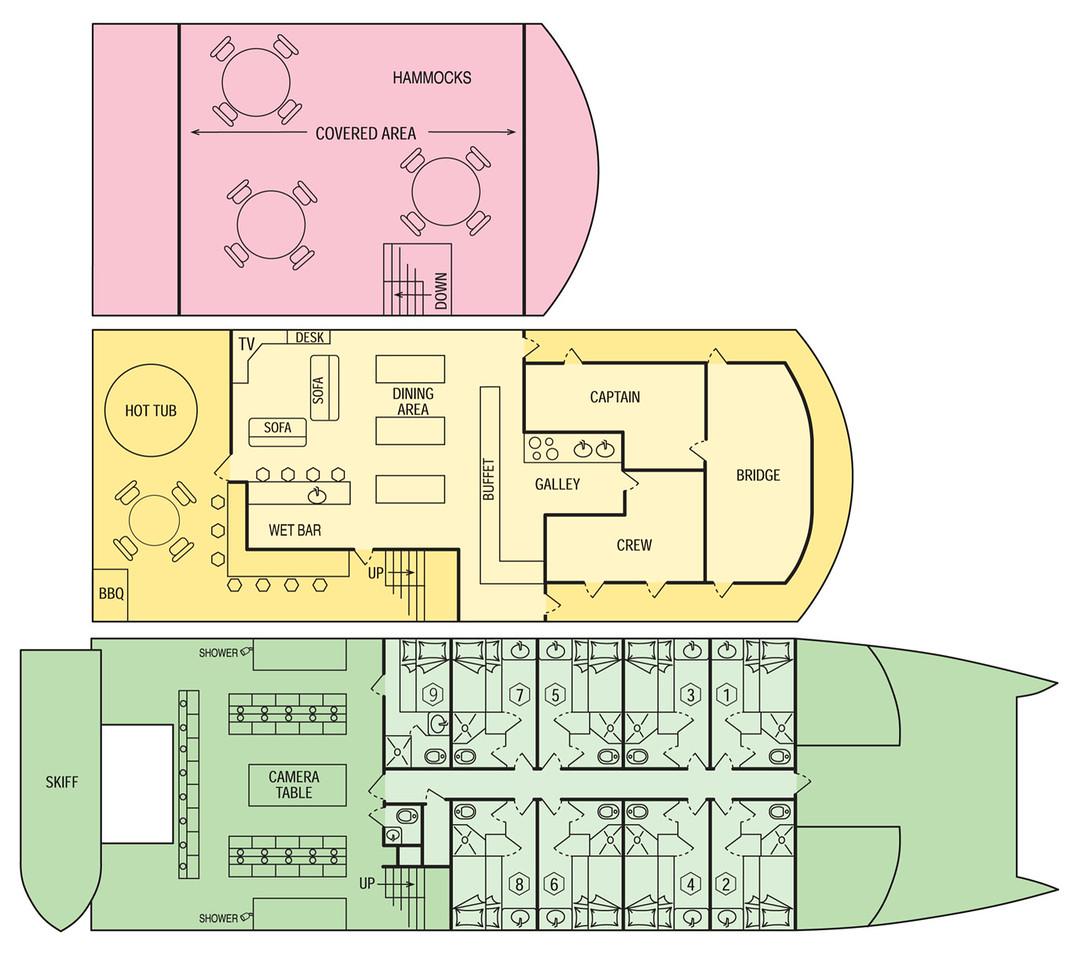Palau Aggressor II
Palau Aggressor II is a 105-foot catamaran with eight deluxe cabins with a queen bed and an upper single bunk, and one double cabin with the same bed configuration. The deluxe cabins are located on the main deck; the double cabin opens to the dive deck. All cabins have private bathrooms, hair dryers and individual climate controls.
The dive deck has personal gear lockers, rinse tanks, two fresh water showers and a camera table with low-pressure air hoses. All dives are made from the 18-passenger dive skiff, which is lowered into the water by a hydraulic cradle. Tanks remain on the skiff and they are filled in place with either air or Nitrox. For relaxing between dives, the partially covered sundeck features a wet bar, hammocks and a hot tub. Inside, the lounge has plenty of room to stretch and watch movies, listen to music and work with your digital photography. Also onboard is a computer station with email access.
 Big Drop-Off
Big Drop-Off
A wall dive that begins as shallow as 2' at low tide and drops to 600'. It is considered by most to be the most beautiful wall dive in Palau because of its abundance of hard and soft corals, seafans, schools of pyramid butterflyfish, and a multitude of tropical reef fish.
Blue Corner
The best known and most highly rated dive site in Micronesia features a shallow coral shelf that projects out into the ocean and has vertical walls on both sides. An upwelling created by the currents attracts schools of fish and large pelagics to the top edges of the walls. The dive is best known for its schools of gray reef sharks that cruise the edge of the wall. Two resident Napoleon wrasses often accompany the divers throughout their dive. Dogtooth tuna, eagle rays, manta rays, white tip and hammerhead sharks, turtles, schooling barracudas, and schools of reef fish populate the site.
Blue Holes
This is a series of four large holes in the top of the reef that converge to form a gigantic underwater chamber. The chamber has a huge opening on a wall that is home to soft corals, sea fans, sea whips and hard corals. Large pelagics often encountered here include tuna, jacks, gray and white tip reef sharks, barracuda and eagle rays. Grouper, Napoleon wrasse, triggerfish, Moorish idols, butterflyfish, anemones and turtles are common at this site, which is situated next to Blue Corner.
Chandelier Caves
A short swim through a tunnel at depth of 35' opens into a cave consisting of three chambers. Beautiful stalactites formed by water dripping down through the rock island above, hang from the ceilings and give the caves their name. Tiny holes to the outside wood allow fresh air to enter the chambers so that divers can surface and admire the beautiful surroundings.
Denges Passage
This natural channel, situated on Palau's eastern coast, is home to an entire family of cuttlefish. The uncommon creatures, related to the squid family, are as accommodating to photographers as they are rare. They are not often encountered by divers because of the relatively few locations in he world where they can be found, their ability to remain relatively motionless, and their excellent camouflage.
German Channel
This man-made channel through the southwest side of the barrier reef is home to two diving areas. One site, known as Manta Rock, is a natural cleaning station where giant manta rays come to have their bodies cleansed of parasites and debris by cleaner wrasses. Gray reef sharks also often avail themselves of the wrasses' services. The area is also inhabited by barracudas, snappers, titan triggerfish, gobies, lionfish, leaffish, and an octopus. Nearby is a coral garden that features crocodile fish, nudibranchs, flatworms, anemones and clownfish.
New Drop-Off
Halfway between Blue Corner and Big Drop-Off, this vertical wall is similar to Blue Corner in that it is a shallow shelf that juts out into the ocean, catching the current and creating an upwelling that attracts schools of pyramid butterflyfish and barracudas, along with a number of gray reef sharks. The steep wall is covered with soft corals and seafans.
Ngedebus Coral Gardens
One of the best collections of hard corals in the Pacific, this dive features a spur and groove reef structure that supports turtles, cuttlefish, anemones, tridacna clams, white tip reef sharks, and thousands of small schooling fish.
Ngerchong
The island of Ngerchong, just beyond Denges Passage has two dive sites nearby: Ngerchong Outside and Ngerchong Coral Gardens. Ngerchong Outside is a sloping wall dive featuring sea fans, anemones, soft corals and many hard coral formations. Sharks, bumphead parrotfish, and schooling fish are frequently seen here, as well as an occasional manta ray. The Coral Gardens, also known as Ngerchong Inside, is probably the best dive in Palau for seeing an abundance and variety of hard corals. Table coral, staghorn coral, elkhorn coral, mushroom coral and brain coral are just some of the varieties of corals found here. In addition, many anemones with clownfish, along with cuttlefish, turtles and other fish thrive here. This dive can be enjoyed at any depth between 10' and 80'.
Peleliu
The island of Peleliu, at the southern tip of the main archipelago of Palau, is bordered by magnificent walls. The dive sites include Peleliu Corner, Yellow Wall, and Orange Beach, among others. Peleliu dive sites are mainly steep walls covered with sea fans, sea whips, hard corals and anemones, but dominated by soft corals. Peleliu is an excellent place to observe large pelagic life, particularly sharks.
Short Drop-Off
A sloping wall just outside the entrance to Koror Harbor that is covered with giant seafans. The top of the wall is a beautiful coral garden loaded with tropical fish and invertebrates.
Siaes Tunnel
An extraordinary deep dive on the west side of the Palau, close to the Ulong Channel. The dive begins on a sheer wall with the opening of the tunnel starting at 70'. You enter through an opening, which is about 50' across and 20' high, and swim through the tunnel, which parallels the wall for 150'. The inside of the tunnel is a large cavern with a ceiling at 80-90' and the floor at 120-130'. Halfway through the tunnel is a "Window" in the wall that looks out onto the deep blue. You exit through a large opening on the wall at 80'. Stingrays, turtles, schools of jacks, and sharks can be seen in and around the tunnel.
Ulong Channel
This channel is located on the west side of Palau, close to Siaes Tunnel and Wall. Its entrance is surrounded by walls that are topped by beautiful coral gardens. On the incoming tide, the mouth of the channel is filled with gray reef sharks. The channel extends for a distance of approximately one-half mile, averaging 100' in width. The maximum depth is about 60'. Coral covered walls run the length of the channel on either side. A shallow ridge running the center of the channel is blanketed with soft corals, hard corals, sea fans, and anemones. Unique to this site is a huge patch of plate coral resembling lettuce leaves that is home to schools of squirrelfish, soldierfish and glasseyes. The current provides a gentle push, resulting in a beautiful, leisurely ride along the channel.
Wonder Channel
Located within the rock islands just a short distance from Jellyfish Lake and Clam City, this channel is best dived on the east side along a wall that starts at the surface and reaches a depth of 80'. Soft corals, sea fans, anemones, blue and red starfish, crown of thorns star-fish, crabs, pipefish, and a large variety of sea slugs, flat worms and nudibranchs can be found along this wall.
Wreck of the Iro Maru
A 145' long merchant ship sunk during World War II by American bombers, the Iro Maru sits upright in 120' of water just 10 minutes south of Koror. Three mast and gun turrets at the bow and stern support a large variety of invertebrates and hard corals. The main deck is at a depth of 80'with open holds containing oil drums and machinery.


